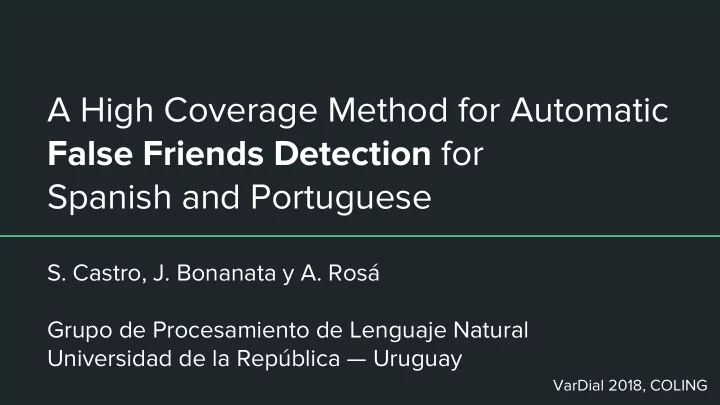

A High Coverage Method for Automatic False Friends Detection for Spanish and Portuguese S. Castro, J. Bonanata y A. Rosá Grupo de Procesamiento de Lenguaje Natural Universidad de la República — Uruguay VarDial 2018, COLING
Introduction Objective : classify between false friends or cognates for Spanish-Portuguese False friends : pair of words from different languages that are written or pronounced in a similar way, but have different meanings.
Example False Friends obligado — obrigado no — no aceite — aceite borracha — borracha cadera — cadeira desenvolver — desenvolver propina — propina
Motivation False friends make harder to learn a language or to communicate , especially when it’s similar to the mother tongue. ● Between Spanish and Portuguese, the amount of cognates reaches the 85% of the total vocabulary (Ulsh, 1971).
Related Work Frunza, 2006 : supervised machine learning using orthographic distances as features to classify between cognates , false friends or unrelated .
Related Work Mitkov et al., 2007: used a combination of distributional and taxonomy-based approaches. Worked with English-French, English-German and English-Spanish. They use WordNet taxonomy similarities to classify, and if a word is missing they fall back to a distributional method.
Related Work Mitkov et al., 2007 For the distributional method they build vectors based on word windows, computing the co-occurrence probability. Then, they compared the N closest words of each word in the pair, translate one of them and count occurrences in the other one. They defined a threshold based on Dice coefficient.
Related Work Ljubešić et al., 2013 : based on (Mitkov et al., 2007), experiment with several ways to build the vector space (e.g. tf-idf) and measure vector distances (e.g. cosine distance). They also proposed to use PMI. They worked with closely related languages: Slovene and Croatian.
Related Work Sepúlveda and Aluísio, 2011 : false friends resolution for Spanish-Portuguese, highly based on (Frunza, 2006). They added an experiment with a new feature whose value is the likelihood of translation , from a probabilistic dictionary (generated taking a large sentence-aligned bilingual corpus).
Word Vector Representations Related work crafted their own word vector representations. We propose to use the skip-gram-based word2vec model (Mikolov et al, 2013a).
Transform between Vector Spaces Mikolov et al, 2013b: propose a method to correspond two word2vec vector spaces via a linear transformation . Used to build dictionaries and phrase tables.
Transform between Vector Spaces
Our Method Build word2vec vector spaces, find a linear transformation and measure vector distances. Note that we don’t cope with related/unrelated, we just focus on cognate/false friends
Our Method
Our Method We used the Wikipedia ’s for the vector spaces. Open Multilingual WordNet (Bond and Paik, 2012) was used as a bilingual lexicon to fit the linear transformation: we iterate over synsets and took lexical units from each language. Then we employed Least Squares.
Our Method We take one of the word vectors, transform it to the other space and compute: 1. The cosine distance between T(source_vector) and target_vector. 2. The number of word vectors in the target vector space closer to target_vector than T(source_vector). 3. The sum of the distances between target_vector and T(source_vector_i) for the top 5 word vectors source_vector_i nearest to source_vector.
Experiments We used (Sepúlveda and Aluísio, 2011) dataset, which is composed by 710 pairs (338 cognates and 372 false friends).
Experiments Method Accuracy Coverage WN Baseline 68.18 55.38 Sepúlveda 2 63.52 100.00 Sepúlveda 3.2 76.37 59.44 Apertium 77.75 66.01 Our method 77.28 97.91 + frequencies 79.42 97.91
Experiments: different configurations Method configuration Accuracy es-400-100 77.28 es-800-100 76.99 es-100-100 76.98 es-200-100 76.84 es-200-200 76.55 pt-200-200 76.13 es-200-800 75.99 pt-400-100 75.99 pt-100-100 75.84 es-100-200 75.83 es-100-100-2 74.98
Experiments: bilingual lexicon
Conclusions ● We have provided a new approach to classify false friends with high accuracy and coverage. ● We studied it for Spanish-Portuguese and provided state-of-the-art results for the pair. ● The method doesn’t require rich bilingual datasets. ○ It could be easily applied to other language pairs.
Future Work ● Experiment with other word vector representations and state-of-the-art vector space linear transformation. ● Work on fine-grained classifications. ○ E.g., partial false friends.
Thank you! Questions? Code and slides available at: github.com/pln-fing-udelar/false-friends
Recommend
More recommend